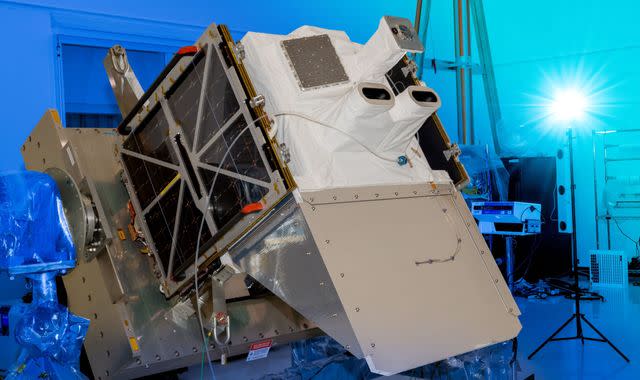SpaceX launches pioneering MethaneSAT satellite to track worst polluting oil and gas sites

A new satellite to monitor oil and gas projects leaking greenhouse gases has been successfully launched by an NGO and Elon Musk's SpaceX space company.
MethaneSAT will measure methane emissions from wide areas that other satellites can't detect and "identify large emitters in places they aren't looking", said US non-profit Environmental Defense Fund (EDF), which developed the satellite with the New Zealand Space Agency.
Just after midnight UK time on Tuesday, MethaneSAT effectively detached from SpaceX's Transporter-10 that blasted it into space.
EDF said MethaneSAT will provide almost real-time data on leaks from the oil and gas sector for companies, regulators and the public to track and see if it matches targets and obligations.
"Cutting methane pollution from fossil fuel operations, agriculture and other sectors is the single fastest way to slow the rate of warming as we continue to decarbonise our energy systems," said EDF President Fred Krupp.
"To do that requires comprehensive data on this pollution on a global scale. MethaneSAT will show us the full scope of the opportunity by tracking emissions to their source."
Methane is a potent greenhouse gas that is more than 80 times more powerful than carbon dioxide at trapping heat in the atmosphere in the short term.
Slashing methane is one of the strongest levers available to slow climate change over the next 20 years, according to the United Nations Environment Programme.
The energy sector is the second biggest source of methane emissions from human activity, following agriculture.
Last year, Sky News revealed 18 oil and gas platforms in the North Sea were losing enough methane to power a city the size of Aberdeen.
The technology already exists to cut 75% of methane emissions from oil and gas, "highlighting a lack of industry action on an issue that is often very cheap to address", according to the International Energy Agency.
A global methane pledge to cut methane emissions by 30% was launched during the COP26 climate conference in Glasgow in 2021, and has since been signed by over 105 countries.
But methane levels continue to reach new record highs.
EDF hopes the satellite, which will circle the earth 15 times a day, will boost transparency in the industry.
"Methane emissions have been overlooked and hard to detect for far too long," said Dr Kelly Levin, chief of science, data and systems change at the Bezos Earth Fund, which helped fund the project.
"From the sky, [MethaneSAT] can see what others can't, helping good actors and holding bad actors accountable."
Dr Johannes Laubach, a scientist at New Zealand research institute Manaaki Whenua - Landcare Research, said the "idea" of publishing the data is that "operators of leaky facilities will be put under pressure to take action".
New Zealand's government is funding research to find out if the satellite can also help quantify emissions from agriculture, where the source tends to be more diffuse rather than concentrated.
Watch The Climate Show with Tom Heap on Saturday and Sunday at 3:30pm and 7.30pm on Sky News, on the Sky News website and app, and on YouTube and Twitter.
The show investigates how global warming is impacting people and the natural world, and highlights the solutions driving the transition away from fossil fuels.


